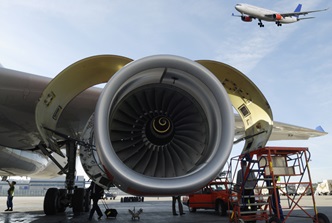- Community
- Servigistics
- Servigistics Blog
- Integrate Technical Information with MRO to Enhanc...
Integrate Technical Information with MRO to Enhance Technician Productivity and Increase Maintenance Velocity
- Subscribe to RSS Feed
- Mark as New
- Mark as Read
- Bookmark
- Subscribe
- Printer Friendly Page
- Notify Moderator
by Ian Boulton
 Why are some of A&D’s most innovative companies focused so intently on improving the quality of technical information to support their MRO people and processes?
Why are some of A&D’s most innovative companies focused so intently on improving the quality of technical information to support their MRO people and processes?
What is leading global manufacturers of passenger, cargo, and military aircraft to invest so heavily in standardizing and automating the creation, management, and delivery of technical information across the wide range of their aircraft service functions?
Why are major A&D suppliers, service providers, and commercial airlines also stepping up their efforts to more tightly integrate technical information with MRO operations?
An obvious motivator is to perform better service faster. No surprise, given the huge cost of aircraft downtime. Take, for example, an Airbus A380. When it’s out of service, the airliner’s operator can lose an estimated $1 million per day.
There are also, of course, the continuing requirements to ensure MRO compliance with A&D industry regulations.
Yet something else is at work here too. In a previous post on the “servitization” of aircraft design, I touched on the heightened demand for air transportation as a top driver of A&D companies’ increasing attention to service lifecycle management solutions. Have you noticed the rising volume of aircraft crisscrossing our skies? Expect it to climb even higher – especially as the world’s emerging economies increasingly take to the air.
With more air travel will come more planes – and more demand for service.
The MRO boom in A&D is already on. Manufacturers and fleet operators – focused on optimizing aircraft uptime – are seeing the growing need and hiring aggressively. Just one point of proof: A recent Boeing annual report projected that “demand for new aircraft will require an average of 30,000 new maintenance personnel per year through 2029.”
But the service challenge isn’t just to deliver more capacity. It’s to deliver more capacity with more efficiency. This is where A&D’s sharpened focus on technical information can be key to transforming MRO.
First, Break Down the Silos
Every service team strives to get the right person with the right information and parts to the right place at the right time. Their goal: to fully meet the service need in a single stop.
If only it were easy.
A&D’s best-in-class service performers aim higher still. Their objective is to know the equipment’s service and usage history so well they can anticipate potential aircraft performance problems and proactively work to prevent them before downtime costs ever set in.
Too often, though, problems with technical information stand in the way. When product documentation is created in silos – by disparate departments and functions, using disparate methods and platforms – it may meet immediately urgent needs, but it also tends to be static, hard to understand, not easily accessible, and disconnected from the latest product data. Inconsistencies and inaccuracies are too often the norm. Service teams struggle with a support resource falling short of what they really need.
Perhaps worse, the silos stay in place. Producing technical information in isolation remains a transactional process – more reactive than strategic. The resulting documentation contributes little to coordinating the company’s global engineering, product support, and MRO teams. Service inefficiencies persist across the enterprise.
The Single Source of Truth
Here’s an alternative scenario. Why not use technical information, not simply as a relevant publication, but as an integral part of the MRO solution itself? Why not use dynamically created job cards that contain the relevant “modules” and “tasks” and put product-smart, configuration-specific technical information at the heart of every MRO function?
Service organizations working toward this vision call it their “single source of truth.” All technicians quickly and easily access the technical information they need, while having confidence it reflects the latest product designs, the right product configurations, and the right context for the particular task at hand.
A&D leaders are now relying on product-smart technical information like this to gain a competitive edge. They are not only creating product documentation faster, they are supporting their MRO teams better. And these integrated technical information solutions are ultimately proving cheaper, because the higher rates of first-time fixes and the greater success in preventive maintenance they achieve are working to cut service costs overall.
With product-smart technical information at the center of MRO, the effects can be truly transformative. Service leaders see how it can be key to streamlining processes, improving productivity, and increasing maintenance velocity. And with more air travel demanding higher rates of aircraft uptime, they know the solution’s bottom-line benefit will be… a better bottom line.
Originally published on 4/7/2014
 Have the Right Service Part for the Job Every Time Have the Right Service Part for the Job Every Time |
How Global Manufacturers Can Better Manage Technical Information |
 EMC Transforms to Improve Service Productivity and Increase Customer Satisfaction EMC Transforms to Improve Service Productivity and Increase Customer Satisfaction |
- Please join us as we kick off this month’s SLM ses...
- Integrate Technical Information with MRO to Enhanc...
- The Keys to Best in Class Service [Infographic]
- Simplicity Within Complexity: How Technical Info A...
- Proof That Customer-First Service Pays Off
- Why Your Competition is Betting on Remote Intellig...
- PTC Servigistics Remote Service version 1.0 Releas...
- Field Service Mobile 11.1.3 - Coming in April
- Field Service Mobile 10.7.8 - Updated Apple Push N...
- Field Service Mobile version 11.1.2 Released to Ap...


